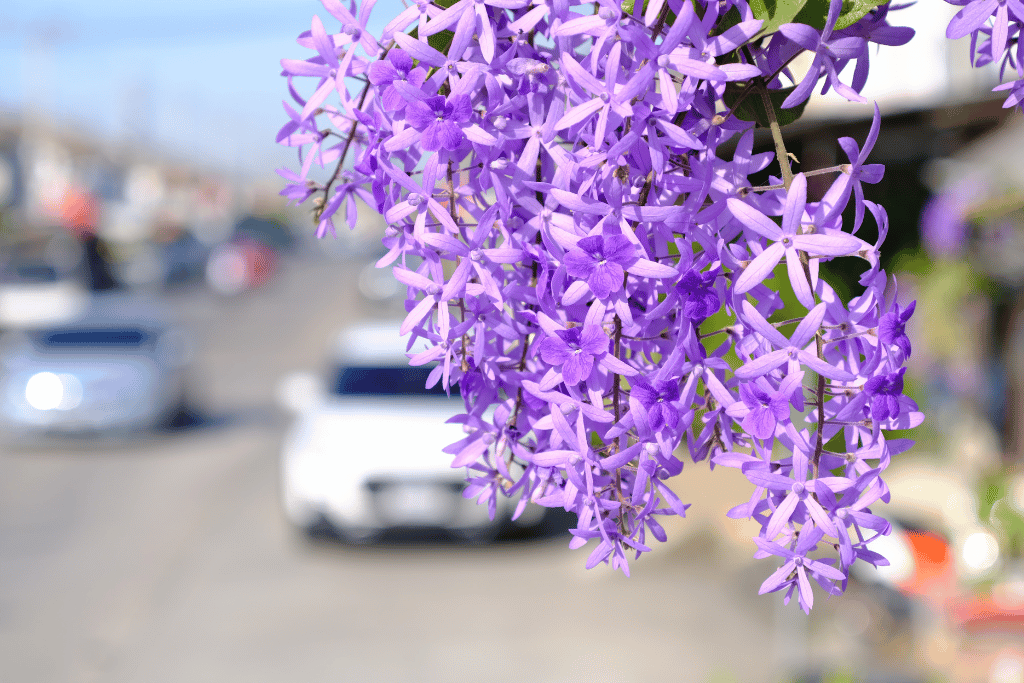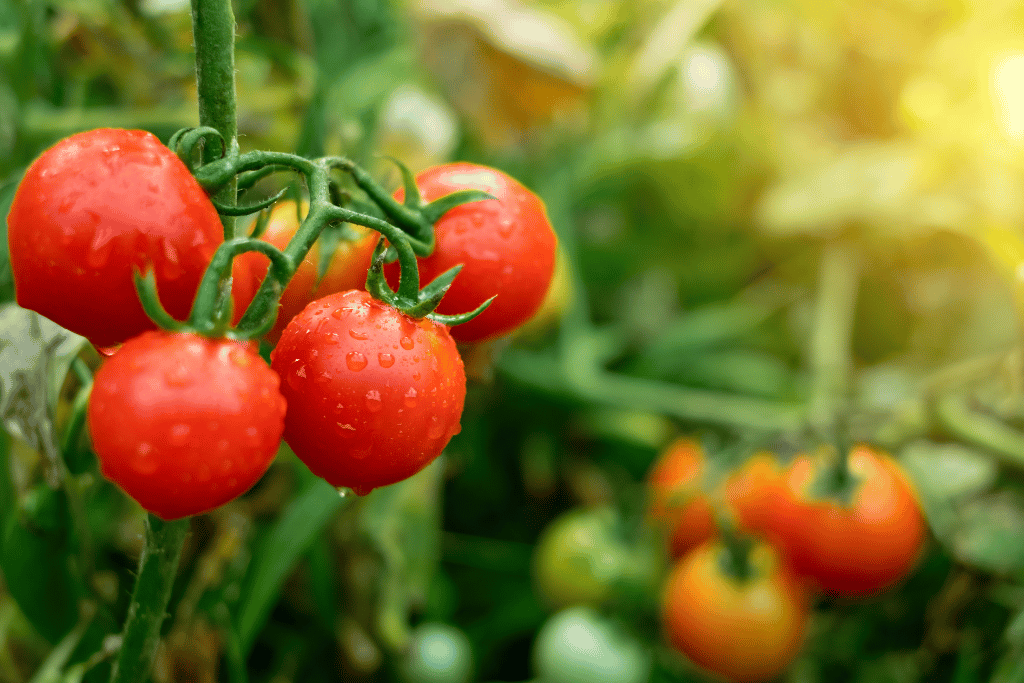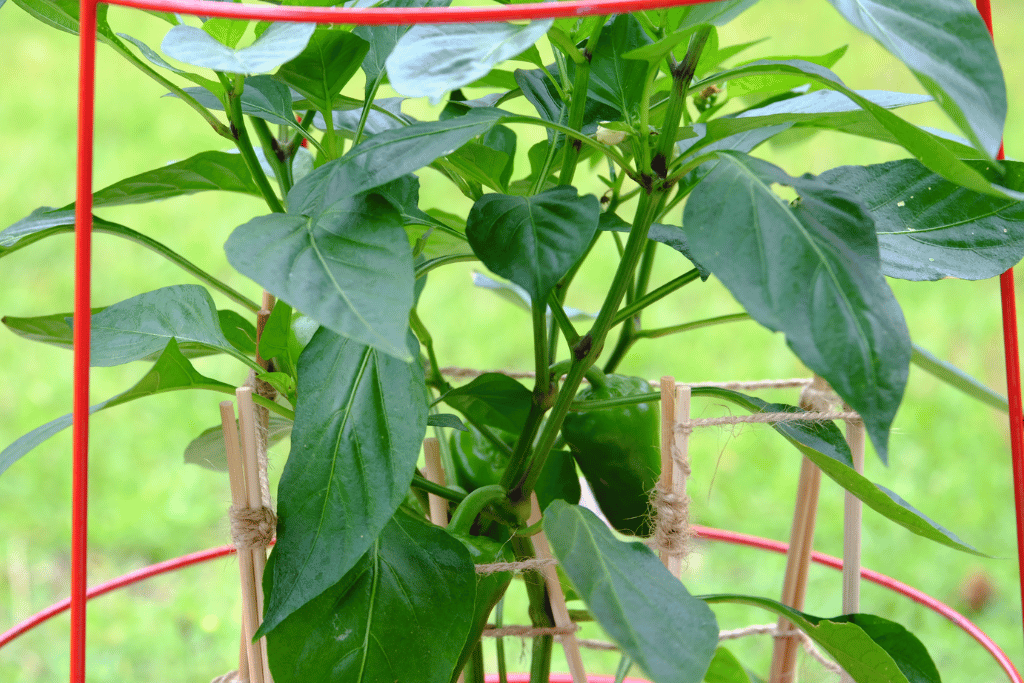
In gardening, some plants need a little help to stand tall and grow well. Bell peppers are one of those plants, and a trellis is a handy tool that can assist them in their growth. But let’s start by understanding what a trellis is and why it’s important for pepper plants. I will also shed light on whether jalapenos and banana peppers share the same needs and the various options available for supporting these plants.
So, let’s address the question: Do peppers need a trellis or not!
What is a Trellis?
A trellis is like a friendly guide for plants. It’s a structure made of vertical or horizontal supports that helps plants, like peppers that grow upwards. Imagine it as a helping hand that supports the plant’s journey towards the sun.
Why Do Bell Peppers Need a Trellis?
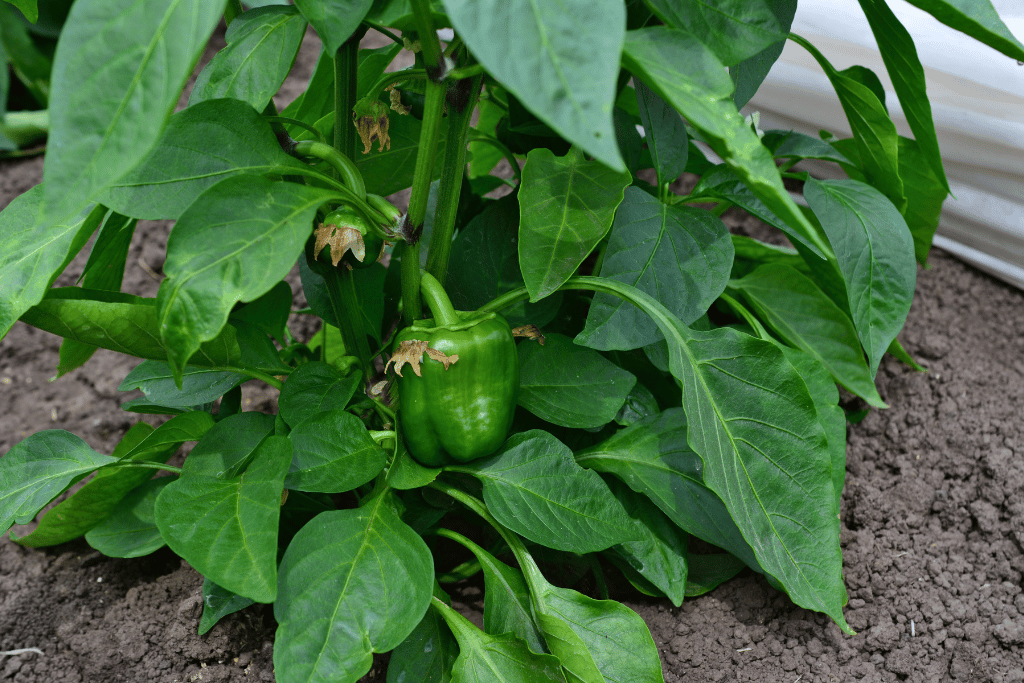
Wondering why do pepper plants need support? Here are the reasons:
- Keeping Them Upright: Pepper plants can grow quite tall and produce heavy fruits. Without support, they may bend or even break under the weight.
- Good Airflow: A trellis allows air to circulate around the plants, which helps prevent diseases that can thrive in still air.
- Pest Control: Elevating pepper plants off the ground can make it harder for pests to reach them, making it easier to protect your plants.
- Harvesting Made Easy: When pepper plants grow vertically, it’s simpler to harvest the fruits. You won’t have to bend down or search through tangled branches. Also, you must know when to pick bell peppers.
- Fruit Protection: Keeping peppers off the ground reduces the chances of rotting or pest infestations.
- Maximizing Sunlight: By lifting the plants, trellises ensure that each part of the plant gets adequate sunlight, promoting healthy growth.
- Space Efficiency: Trellised pepper plants use vertical space effectively, making them suitable for smaller gardens or limited planting areas.
- Preventing Soil Splashing: When it rains, soil can splash onto the leaves of plants. Trellises help keep the lower parts of the plant clean.
- Reducing Weeding: Trellised plants often shade the soil beneath them, reducing weed growth and the need for frequent weeding.
- Enhanced Aesthetic: Trellised pepper plants can be an attractive addition to your garden, adding visual interest and structure.
Why Should You Prepare a Trellis for Your Pepper Plant?
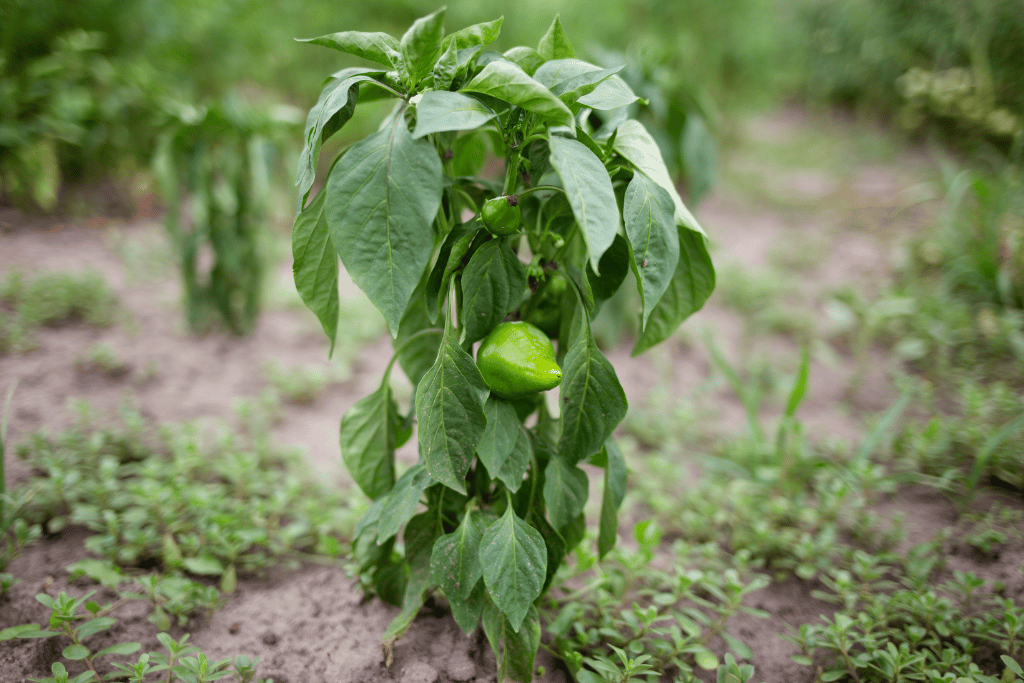
Now, let’s get into the importance of preparing a bell pepper trellis:
Pepper plants, including bell peppers, thrive when they have proper support. Here’s why you should consider preparing a trellis for your pepper plant:
- Sturdy Upright Growth: Pepper plants tend to grow tall and bear fruit. A trellis provides essential support, keeping them upright and preventing bending or breakage. And thus, ensuring that the bell pepper goes through the growing stages easily.
- Disease Prevention: Elevating pepper plants on a trellis allows for better air circulation. This reduces the risk of diseases caused by stagnant, humid conditions.
- Effective Pest Management: With pepper plants raised off the ground, it’s more challenging for pests to reach them. This can simplify pest control efforts and protect your plants.
- Effortless Harvesting: When pepper plants are trellised, their fruits are easier to access. You won’t need to bend down or search through tangled foliage to harvest them.
- Fruit Protection: By keeping peppers off the ground, trellises reduce the likelihood of fruits rotting or being damaged by pests.
- Optimal Sunlight Exposure: Trellised pepper plants receive more even sunlight distribution, promoting uniform growth and higher yields.
- Space Efficiency: For gardens with limited space, vertical gardening with trellises maximizes growing area.
- Reduced Soil Splashing: Trellises prevent soil from splashing onto plant leaves during rainfall, minimizing the risk of soil-borne diseases.
- Weed Control: Trellised plants create shade beneath them, reducing weed growth and the need for frequent weeding.
- Aesthetic Appeal: Trellised pepper plants not only improve growth but also add visual interest and structure to your garden.
Types of Trellises for Bell Peppers
Supporting your bell pepper plants with the right trellis can make a significant difference in their growth and productivity. Trellises come in various forms, each designed to suit different needs and gardening spaces. In this section, we’ll explore different types of trellises for bell peppers and how to choose the right one for your garden.
Vertical Trellises
Vertical trellises help your bell pepper plants grow upwards, making the most of vertical space and promoting healthy growth.
1. Single-Stake Trellis
A single-stake trellis is a straightforward and cost-effective option. It involves driving a single tall stake or pole into the ground beside each pepper plant. As the plant grows, gently tie it to the stake at intervals to provide support.
Pros:
- Suitable for compact pepper varieties.
- Budget-friendly.
- Allows for easy access to the plant for maintenance and harvesting.
Cons:
- May not provide adequate support for heavy fruit loads.
- Requires regular maintenance, including tying the plant to the stake as it grows.
2. A-Frame Trellis
An A-frame trellis consists of two stakes joined at the top in the shape of an “A.” This design provides support on both sides of the pepper plant and is particularly useful for larger varieties.
Pros:
- Suitable for taller and sprawling pepper varieties.
- Provides balanced support from both sides of the plant.
- Can accommodate heavy fruit loads.
Cons:
- Requires more space than single-stake trellises.
- Initial setup may be slightly more involved.
3. Tomato Cage Trellis
Tomato cages, typically used for supporting tomato plants, can also serve as effective trellises for bell peppers. These cages have a circular shape and surround the pepper plant as it grows.
Pros:
- Ready-made and readily available at garden stores.
- Provides circular support as the pepper plant grows.
- Works well for both compact and larger varieties.
Cons:
- May be more expensive than single-stake trellises.
- Limited customization options compared to other trellis types.
Horizontal Trellises
Horizontal trellises encourage your bell pepper plants to spread out along a horizontal plane, allowing for easier access and maintenance.
1. String Trellis
A string trellis involves using strings or wires strung between horizontal supports to create a grid-like structure. Pepper plants can grow through this grid, spreading out horizontally.
Pros:
- Versatile and adaptable to different garden layouts.
- Allows for even spacing and sunlight exposure.
- Supports sprawling varieties effectively.
Cons:
- Requires more initial setup compared to single-stake trellises.
- May need occasional adjustments to maintain plant positioning.
2. Fence Trellis
If you have an existing garden fence, you can utilize it as a natural trellis for your bell peppers. Pepper plants can be trained to climb the fence, making the most of available vertical space.
Pros:
- Utilizes existing garden structures.
- Minimal additional setup required.
- Can work well for smaller gardens or limited spaces.
Cons:
- Limited customization compared to standalone trellises.
- May not provide as much support for heavy fruit loads as some other trellis types.
3. T-Shaped Trellis
A T-shaped trellis combines both vertical and horizontal elements, offering robust support for bell pepper plants. It consists of a vertical post with horizontal arms extending on either side, creating a T-shape.
Pros:
- Provides sturdy support for both upright and sprawling pepper varieties.
- Maximizes space efficiency by offering support in multiple directions.
- Can handle heavy fruit loads effectively.
Cons:
- Requires more initial setup and materials.
- May be bulkier than other trellis types, so adequate spacing is needed.
Factors to Consider When Choosing a Trellis for Your Bell Peppers
Pepper Variety: Consider the growth habits of your pepper plants. Compact varieties may do well with single-stake or tomato cage trellises, while larger, sprawling varieties may benefit from A-frame or T-shaped trellises.
Garden Space: Evaluate the available space in your garden. Vertical trellises like single-stake or A-frame trellises work well in smaller spaces, while horizontal options like string trellises or fence trellises can be suitable for larger areas.
Planting Layout: Consider your planting layout and how you want your bell pepper plants to grow. If you prefer a more compact, vertical arrangement, opt for vertical trellises. For a spread-out, horizontal growth pattern, horizontal trellises are ideal.
Budget: Your budget may influence your choice of trellis. Simple trellises like single-stake or string trellises tend to be more budget-friendly, while more elaborate designs may come at a higher cost.
Maintenance: Think about the level of maintenance you’re willing to invest. Some trellises, like single-stake trellises, require more frequent tying and adjustments, while others, like tomato cage trellises, are relatively low-maintenance.
These factors will allow you to choose the right trellis that suits your garden’s needs and helps your bell pepper plants thrive. Proper support ensures healthier plants, improved yields, and a more organized garden. So, whether you opt for a vertical or horizontal trellis, your bell peppers are sure to benefit from the extra care and support you provide.
Do Bell Pepper Plants Need Cages?
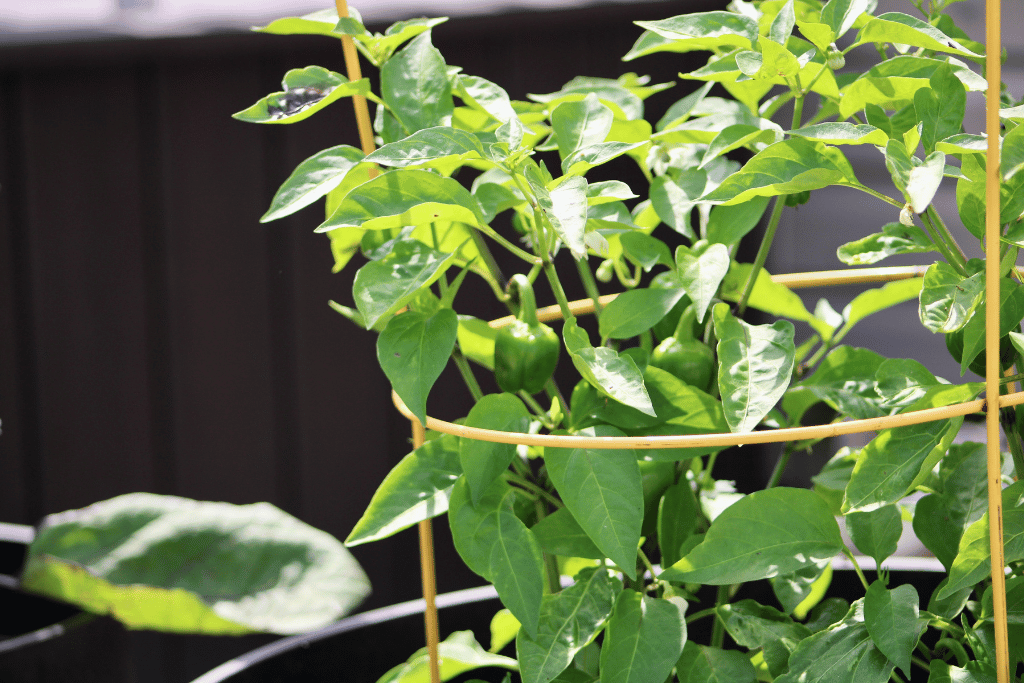
Apart from a trellis, some gardeners prefer cages for bell pepper plants. But the question is: do bell pepper plants need cages or a trellis?
While trellises are a popular choice for supporting bell pepper plants, cages are another effective option worth considering.
The Role of Cages in Supporting Bell Pepper Plants
Cages act as protective hugs for your bell pepper plants, encircling them and offering stability and support as they grow. But why might you consider using cages for your bell peppers, and how do they compare to trellises?
Protection and Stability
One of the primary roles of cages is to provide protection and stability to bell pepper plants. As your pepper plants grow and start bearing fruits, they can become top-heavy, increasing the risk of branches bending, breaking, or even uprooting the entire plant. Cages serve as a strong support structure, preventing these issues and keeping your plants firmly grounded.
Upright Growth
Cages encourage bell pepper plants to grow upright, which is essential for efficient sunlight absorption and optimal air circulation. When your pepper plants stand tall and proud, they can make the most of available sunlight, leading to healthier and more productive plants.
Fruit Protection
Cages also play a crucial role in protecting the fruits. By keeping the peppers off the ground, they reduce the chances of fruits touching the soil, which can lead to rotting or pest damage. This added protection helps ensure that your bell peppers develop into plump and healthy fruits.
Minimal Maintenance
Compared to some trellis types that require regular tying and adjustments as the plants grow, cages are relatively low-maintenance. Once installed properly, they provide consistent support throughout the growing season, requiring minimal interference.
Suitable for Compact Varieties
Cages are particularly well-suited for compact bell pepper varieties that don’t grow as tall or wide as some other pepper types. For these smaller plants, a cage can offer the right level of support without excessive infrastructure.
Comparing Trellises and Cages for Bell Peppers
Now that we understand the role of cages in supporting bell pepper plants, let’s compare them to trellises, another common support option.
Space Requirements
- Trellises: Trellises are vertical or horizontal structures that require some space around the plant. While they can maximize vertical growing space in smaller gardens, they still need room for installation and maintenance.
- Cages: Cages take up relatively less space, making them suitable for smaller gardens or those with limited planting areas. They encircle the plant and don’t require additional space beyond their immediate footprint.
Support
- Trellises: Trellises provide support mainly in one direction – either vertically or horizontally. The choice depends on the trellis type and how it’s set up.
- Cages: Cages offer 360-degree support, surrounding the plant from all sides. This comprehensive support is beneficial, especially for bell pepper plants with a bushier growth habit.
Cost
- Trellises: Trellises come in various designs and materials, which can impact their cost. Some simple trellises may be more budget-friendly, while custom or decorative trellises can be more expensive.
- Cages: Cages are typically available in standard sizes and materials, making them a cost-effective choice for supporting bell pepper plants. They provide good value for the support they offer.
Maintenance
- Trellises: Some trellis types, such as single-stake trellises, require frequent tying and adjustments as the pepper plants grow. This ongoing maintenance can be time-consuming.
- Cages: Cages are relatively low-maintenance. Once installed, they provide consistent support, requiring only occasional checks to ensure the plant remains within the cage’s boundaries.
Suitability for Different Varieties
- Trellises: The suitability of trellises depends on the specific type and size of the trellis. Some trellises may work better for compact varieties, while others are designed for larger, sprawling plants.
- Cages: Cages are versatile and can effectively support a wide range of bell pepper varieties, from compact to more expansive ones. They are adaptable to different plant sizes.
How to Effectively Use Cages for Bell Pepper Plants
If you decide to use cages to support your bell pepper plants, here are some steps to ensure they work effectively:
1. Select the Right Size
Choose cages that are tall enough to support the anticipated height of your bell pepper plants. Bell pepper varieties vary in size, so select cages that accommodate the potential growth.
2. Place Them Early
Install the cages around your pepper plants when they are young, preferably at the time of transplanting or shortly afterward. This early placement prevents disturbing the plant’s roots as it matures.
3. Secure Branches
As your bell pepper plants grow, gently guide their branches through the openings in the cage. This helps the plant stay within the cage’s structure and provides additional support.
4. Regular Inspection
Periodically check your bell pepper plants and the cages to ensure that the plants are growing within the cage’s boundaries. Adjustments may be needed as the plants continue to grow and produce fruits.
5. Fertilization and Watering
Remember to provide proper fertilization and watering to your bell pepper plants throughout the growing season. Healthy plants are better equipped to take full advantage of the support provided by the cages.
Cages are a practical and effective alternative to trellises for supporting bell pepper plants. They offer comprehensive support, protect fruits, require minimal maintenance, and are suitable for a wide range of pepper varieties. By selecting the right size and properly installing cages around your bell pepper plants, you can help ensure their healthy growth and a bountiful harvest.
How to Support Pepper Plants: The Steps
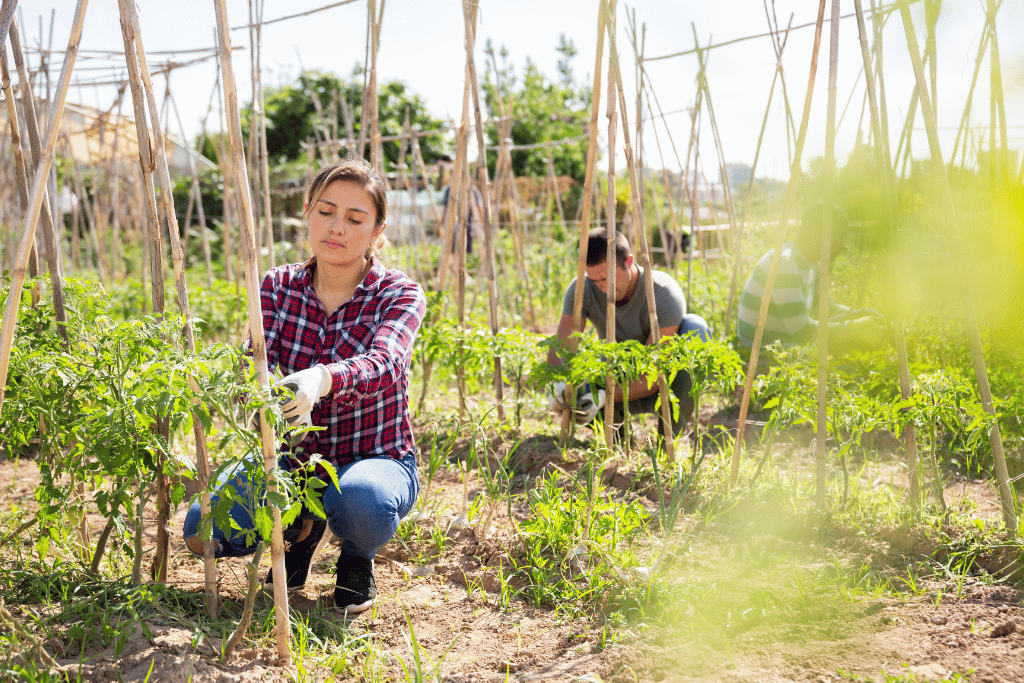
1. Choose the Right Trellis
Selecting the appropriate trellis is the first crucial step in effectively supporting your pepper plants. Consider the following factors:
- Pepper Variety: Different pepper types have distinct growth habits. Determine whether your pepper plants are compact or sprawling, as this will influence the trellis type you need.
- Space Availability: Evaluate the space in your garden and choose a trellis that fits comfortably within that area. Vertical trellises are excellent for maximizing space.
- Trellis Material: Trellises come in various materials, including wood, metal, and plastic. Choose a material that suits your garden’s aesthetic and durability requirements.
2. Proper Installation
Once you’ve selected the right trellis, it’s essential to install it correctly. Here’s how:
- Placement: Position the trellis near your pepper plants, allowing enough space for the plants to grow comfortably. It’s best to install the trellis when you first plant or transplant your peppers.
- Secure Anchoring: Ensure the trellis is anchored securely to the ground or a stable structure, depending on its design. This prevents it from toppling over as your pepper plants grow.
- Height Consideration: Adjust the trellis’s height to accommodate the anticipated height of your pepper plants. It’s essential to provide ample room for the plants to grow upwards.
3. Plant Properly
Plant your pepper seedlings or transplants near the base of the trellis, ensuring they have adequate space between them. Proper spacing allows each plant to grow without overcrowding.
4. Training Your Pepper Plants
As your pepper plants grow, you’ll need to guide them along the trellis structure. Here’s how to do it effectively:
- Tying or Twining: Use soft ties, twine, or gardening tape to gently secure the branches to the trellis. Be careful not to tie them too tightly, allowing room for growth.
- Regular Monitoring: Periodically check your pepper plants’ growth and adjust their positioning and ties as necessary to keep them well-supported.
5. Regular Maintenance
To ensure the continued success of your trellised pepper plants, follow these maintenance practices:
- Pruning: Trim any excessive foliage or unwanted growth to promote better airflow and prevent overcrowding.
- Pest and Disease Monitoring: Regularly inspect your plants for signs of pests or diseases and take appropriate action if necessary.
- Watering and Fertilizing: Provide consistent and appropriate watering and fertilization to keep your pepper plants healthy and thriving.
- Harvesting: When it’s time to harvest your peppers, do so carefully to avoid damaging the plant or trellis structure.
6. Adjustments as Needed
Throughout the growing season, you may need to make adjustments to the trellis, ties, or the way you’re training your pepper plants. Pay attention to their growth patterns and ensure they remain well-supported.
7. End-of-Season Care
When the growing season comes to a close, it’s essential to remove any remaining plant material from the trellis and store it properly for the next season. Cleaning and storing your trellis correctly ensures its longevity.
So you see, supporting your pepper plants with a trellis is a practical and effective way to promote their healthy growth, maximize your harvest, and enhance the overall aesthetics of your garden.
How to Stake Pepper Plants
Yes, Pepper plants are a popular choice for gardeners, but they can be susceptible to wind damage and breakage, especially when they are loaded with fruit. Therefore, staking pepper plants can help to support them and prevent them from falling over. There are a few different ways to stake pepper plants, but the most common method is to use a single stake.
What You Will Need
- Stakes (wooden, bamboo, or metal)
- Garden twine or soft cloth ties
- Scissors
Instructions
- Choose a stake that is tall enough to support your pepper plant. A stake that is 4-6 feet tall is a good choice for most pepper varieties.
- Drive the stake into the ground next to the pepper plant, about 2-3 inches away from the stem. Make sure that the stake is at least 6 inches deep in the ground.
- Use garden twine or soft cloth ties to tie the pepper plant to the stake. Start by tying the plant to the stake at the base of the plant. Then, as the plant grows, tie it to the stake at several points along the stem. Be careful not to tie the plant too tightly, as this can restrict its growth.
Tips
- Stake your pepper plants early in the season, before they get too tall and heavy.
- If you are growing peppers in windy conditions, you may need to use a heavier stake or multiple stakes to support each plant.
- Check your pepper plants regularly and tighten the ties as needed.
- As the plant grows, you may need to add additional ties or stakes.
Different Types of Stakes
There are a few different types of stakes that you can use to stake pepper plants. The most common type is a wooden stake. Wooden stakes are relatively inexpensive and easy to find. However, they can be susceptible to rotting and may need to be replaced every year or two.
Another type of stake that you can use is a bamboo stake. Bamboo stakes are more durable than wooden stakes and are less likely to rot. However, they can be more expensive than wooden stakes.
Metal stakes are the most durable type of stake, but they can also be the most expensive. Metal stakes are a good choice if you live in a windy area or if you are growing large pepper plants.
Different Ways to Tie Pepper Plants to Stakes
There are a few different ways to tie pepper plants to stakes. The most common method is to use garden twine.
Garden twine is soft and pliable, so it will not damage the plant. To tie a pepper plant to a stake with garden twine, simply wrap the twine around the stake and the plant several times and then tie it off.
Another way to tie pepper plants to stakes is to use soft cloth ties. Soft cloth ties are also gentle on the plant and will not damage it. To tie a pepper plant to a stake with soft cloth ties, simply wrap the tie around the stake and the plant several times and then tie it off.
You can also use plastic zip ties to tie pepper plants to stakes. However, be careful not to overtighten the zip ties, as this can damage the plant.
Maintaining Staked Pepper Plants
Once you have staked your pepper plants, it is important to maintain them properly. This includes watering, fertilizing, and weeding around the plants. It is also important to check the stakes regularly and make sure that they are still secure.
Watering: Pepper plants need about 1-2 inches of water per week. Water your pepper plants deeply, so that the water reaches the roots. Avoid watering your pepper plants overhead, as this can promote fungal diseases.
Fertilizing: Pepper plants need to be fertilized regularly. A balanced fertilizer is a good choice for pepper plants. Fertilize your pepper plants every two weeks, following the directions on the fertilizer label.
Weeding: Weeding around your pepper plants is important to prevent weeds from competing with the pepper plants for water and nutrients. Weed around your pepper plants regularly, being careful not to damage the pepper plants.
Checking the Stakes: Check the stakes that you are using to support your pepper plants regularly. Make sure that the stakes are still secure and that they are not damaging the pepper plants. If a stake is not secure, drive it deeper into the ground. If a stake is damaging a pepper plant, remove it and replace it with a different stake.
Staking pepper plants is a simple way to support them and prevent them from falling over. By following the tips above, you can easily stake your pepper plants and help them to thrive.
Do Peppers Need a Trellis When Grown in a Container?
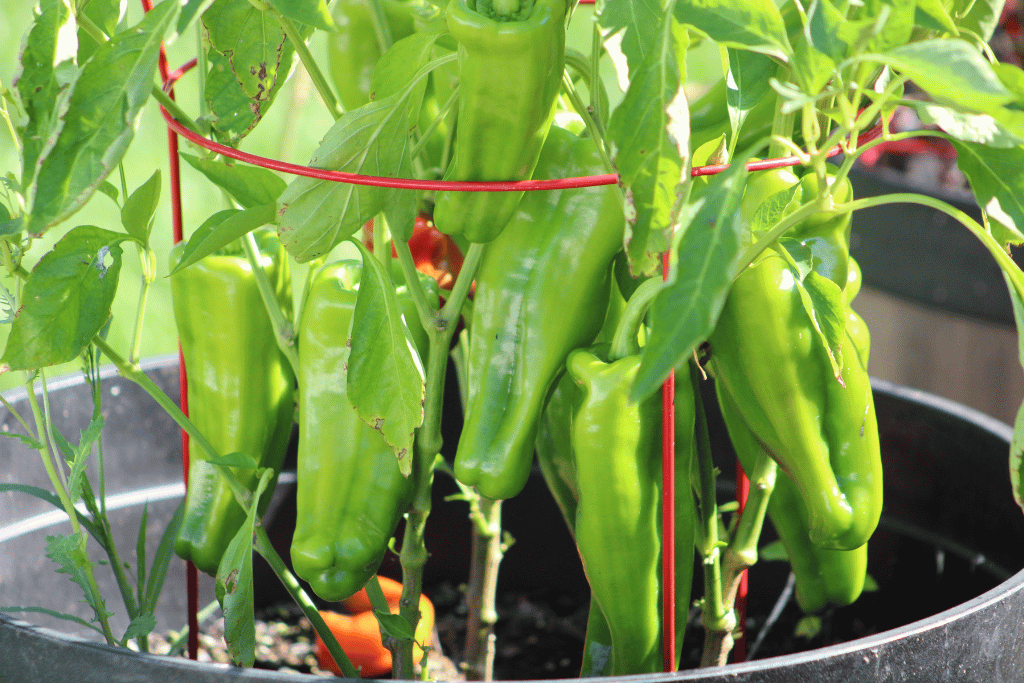
When you grow bell peppers in a container, you might wonder if they need a trellis. A trellis is like a support structure for plants to climb on. Unlike some other plants, bell peppers don’t really need a trellis when grown in a container. They’re not climbers like beans or tomatoes.
Bell pepper plants tend to stay more bushy and don’t naturally grow upwards. So, you can skip the trellis for your pepper plants in containers. However, it does have benefits to trellis it – such as preventing the plant from tipping over.
Should You Grow Bell Peppers in a Container?
Growing bell peppers in containers is a good idea for many people. Here’s why:
Limited Space: If you don’t have a big garden, containers are great. They don’t take up much space, so you can grow bell peppers even if you have a small balcony or patio.
Control: In containers, you have more control over the soil and environment. You can choose the right soil mix and move your peppers to get the best sunlight.
Pests and Weeds: Containers can help protect your peppers from pests and weeds. It’s easier to keep an eye on them and keep unwanted visitors away.
Portability: If the weather changes or you’re moving, you can take your pepper plants with you. They’re portable!
What Are the Steps to Grow Peppers in a Container and How to Trellis Them?
Here are the simple steps to grow bell peppers in a container:
- Choose a Container: Pick a big container with drainage holes at the bottom. This helps water drain out so your peppers don’t get too wet.
- Soil: Use good potting soil or a mix designed for vegetables. Fill the container with this soil.
- Planting: Plant your pepper seeds or small pepper plants in the container. Make a hole in the soil and put the plant in, covering the roots with soil.
- Sunlight: Put your container where it can get at least 6-8 hours of sunlight each day. Peppers love the sun!
- Watering: Keep the soil moist but not soaking wet. Water when the top inch of soil feels dry.
- Fertilizing: Add a balanced fertilizer every few weeks to give your peppers the nutrients they need to grow.
- No Trellis Needed: Remember, bell peppers don’t need a trellis. They grow bushy and won’t climb like some other plants.
- Harvest: When your peppers turn their full color (usually green, yellow, or red), you can pick them. Use scissors or a knife to cut them off the plant.
Do Jalapenos Need a Trellis?
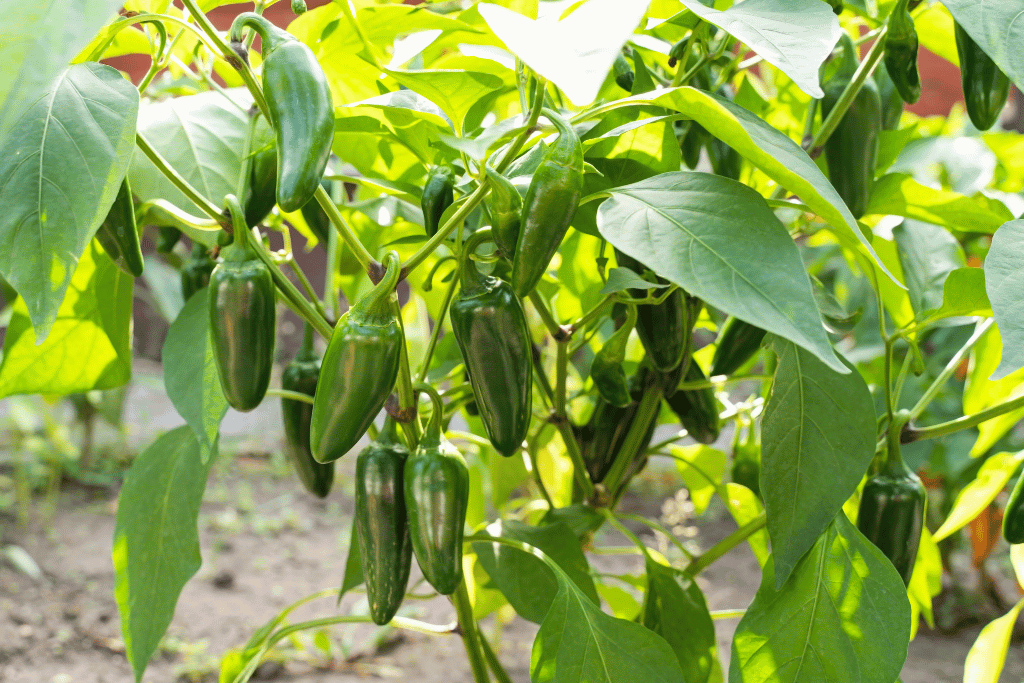
Jalapenos are fiery and flavorful peppers adored by spice enthusiasts. They are a staple in many kitchens around the world. So, do jalapenos need a trellis?
To answer this question, we must delve into the unique characteristics of jalapeno plants, understand their growth habits, and compare them to other pepper varieties, such as bell peppers.
The Jalapeno Plant Overview
Before we explore the necessity of a trellis for jalapenos, it’s crucial to comprehend the characteristics and growth habits of these peppers. Jalapeno plants, scientifically known as Capsicum annuum, belong to the chili pepper family. Unlike some other pepper varieties, jalapenos are not classified as bell peppers. While both belong to the same species, they are distinct varieties with their own unique traits, flavors, and uses.
Jalapenos are known for their spiciness, which is measured on the Scoville Heat Scale. This heat scale quantifies the pungency or spiciness of chili peppers. Jalapenos typically range from 2,500 to 8,000 Scoville Heat Units (SHU), making them notably hotter than bell peppers, which register at 0 SHU since they are not spicy at all.
Read on: When to Pick Jalapenos
Do Jalapenos Need a Trellis?
The need for a trellis primarily depends on the growth habit of the plant and your gardening goals. Unlike certain vining plants like tomatoes or cucumbers, jalapeno plants do not possess a natural tendency to climb or sprawl.
They have an upright and bushy growth habit, which means they typically grow as compact bushes rather than sprawling vines. This inherent growth habit might lead some gardeners to believe that trellising is unnecessary for jalapenos.
However, there are instances where providing support like a trellis can be beneficial for jalapeno plants:
Heavy Fruit Load: If your jalapeno plants are exceptionally productive and bear a heavy load of peppers, the weight of the fruit can sometimes cause the branches to bend or even break. A trellis can help support the weight of the fruit, preventing damage to the plant.
Air Circulation: Good air circulation is essential for healthy pepper plants. Crowded plants with dense foliage can create a favorable environment for diseases like mildew and fungal infections. By spacing out your jalapeno plants on a trellis, you can promote better air circulation and reduce the risk of diseases.
Easy Harvesting: Harvesting jalapenos from trellised plants can be more accessible and convenient. The peppers are often more visible and easier to reach, making it simpler to pluck them when they’re ripe.
Space Optimization: If you have limited garden space, growing jalapenos on a trellis can be a space-saving technique. It allows you to grow vertically, making efficient use of your garden area.
While a trellis can provide these benefits, it’s important to note that it’s not a strict requirement for growing jalapenos. These plants can thrive when grown in the ground or in containers without trellising, provided they receive adequate care in terms of watering, sunlight, and nutrients.
Choosing the Right Trellis
If you decide to trellis your jalapeno plants, it’s essential to choose the right type of trellis. A simple, sturdy trellis made of materials like wood or metal can work well. Ensure it’s tall enough to accommodate the mature height of your jalapeno plants, which typically range from 18 to 36 inches, depending on the variety.
Do Banana Peppers Need a Trellis?
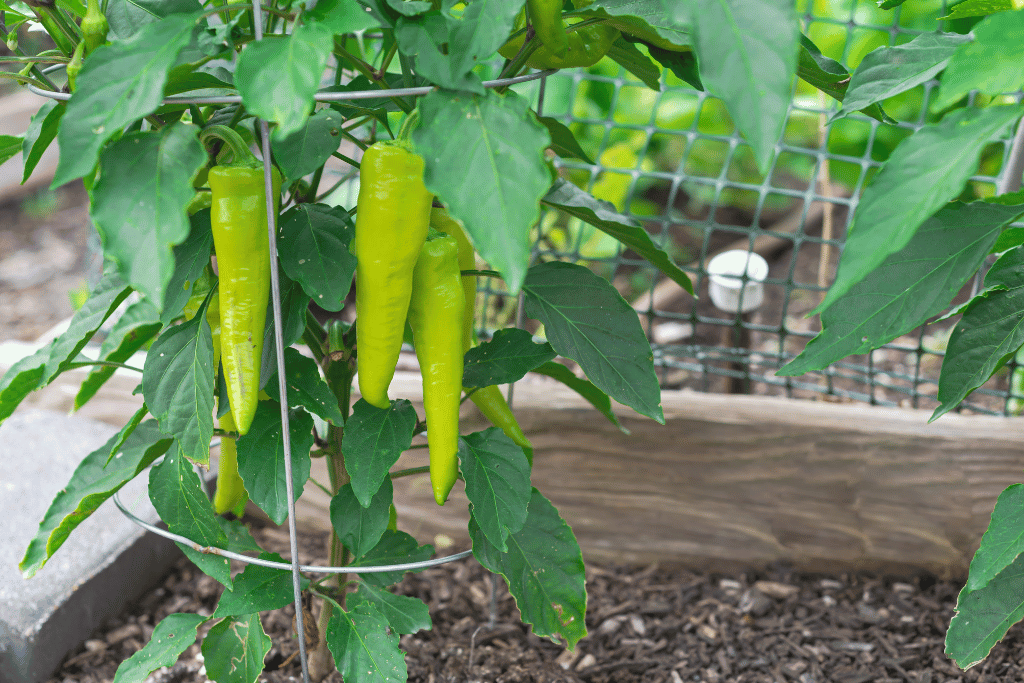
Banana peppers are a popular type of pepper that is known for its mild flavor and yellow color. They are relatively easy to grow and can be enjoyed fresh, pickled, or cooked.
One of the most common questions that gardeners have about banana peppers is whether or not they need a trellis. The answer is that it depends.
Why might you want to trellis banana peppers?
There are a few reasons why you might want to trellis your banana pepper plants:
- Support: Banana pepper plants can grow to be quite tall and heavy, especially when they are loaded with fruit. A trellis can help to support the plant and prevent it from falling over.
- Aeration: A trellis can also help to improve aeration around the plant, which can help to prevent diseases and pests.
- Harvesting: A trellis can make it easier to harvest banana peppers. When the peppers are growing on a trellis, they are easier to reach and less likely to be damaged.
How to trellis banana peppers
If you decide to trellis your banana peppers, there are a few things you need to keep in mind:
- Choose the right trellis: There are many different types of trellises available, so you need to choose one that is the right size and shape for your plants. A simple tomato cage can be a good option for banana pepper plants.
- Place the trellis in the right spot: The trellis should be placed in a sunny spot in your garden. Banana pepper plants need at least six hours of sunlight per day.
- Secure the plants to the trellis: Once you have placed the trellis in the right spot, you need to secure the plants to it. You can use garden ties or soft twine to tie the plants to the trellis.
When to trellis banana peppers?
The best time to trellis banana peppers is when they are young and growing. This will help to prevent the plants from becoming too heavy and falling over.
Do all banana pepper plants need a trellis?
Not all banana pepper plants need a trellis. Some varieties of banana peppers are more compact and less likely to fall over. However, if you are growing a variety of banana pepper that is known to grow tall, or if you live in an area with windy conditions, it is a good idea to trellis your plants.
Other tips for growing banana peppers
In addition to trellising, there are a few other things you can do to help your banana pepper plants thrive:
- Plant in well-drained soil: Banana pepper plants need well-drained soil. If your soil is heavy, you can improve drainage by adding sand or compost to it.
- Water regularly: Banana pepper plants need regular watering. Water the plants deeply once a week, or more often if the weather is hot and dry.
- Fertilize regularly: Banana pepper plants are heavy feeders. Fertilize the plants every two weeks with a balanced fertilizer.
- Mulch around the plants: Mulching around the plants will help to retain moisture and suppress weeds.
So, do banana peppers need a trellis? It depends. If you are growing a variety of banana pepper that is known to grow tall, or if you live in an area with windy conditions, it is a good idea to trellis your plants. However, if you are growing a more compact variety of banana pepper, and you live in an area with calm weather, you may not need to trellis your plants.
Choosing the Right Friends for Bell Peppers
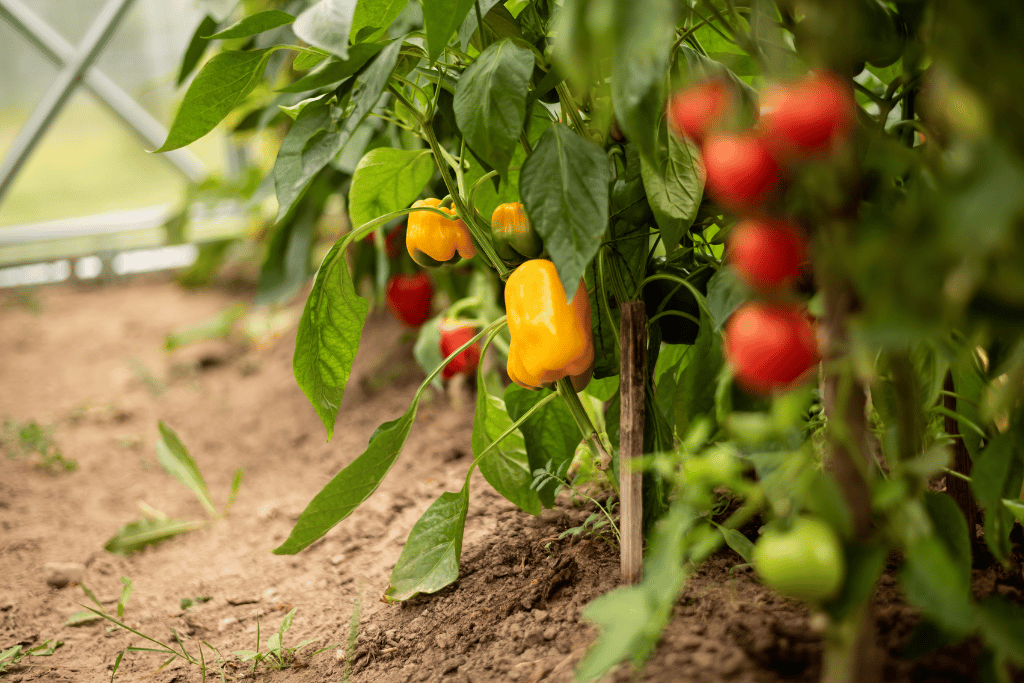
Bell peppers are a delicious addition to your garden, and they can be even happier when they have good companions nearby. Companion plants are like friendly neighbors for your bell peppers, helping them grow better and stay healthier. Let’s learn about some buddies that go well with bell peppers!
1. Tomatoes: Best Buddies
Bell peppers and tomatoes are like best friends in the garden. They help each other grow strong. When they’re planted together, they can share nutrients and keep away some pests that bother them. Just make sure to leave some space between them so they don’t fight for sunlight.
2. Basil: The Aromatic Ally
Basil is a fragrant herb that can be a great companion for bell peppers. It not only adds a lovely scent to your garden but also helps keep away some pesky insects that don’t like the smell of basil. Plant basil near your bell peppers to keep them happy.
3. Onions: Root for Onions
Onions and bell peppers can be like gardening buddies. Bell peppers like the onions’ strong smell, which can help keep away pests. Plus, onions grow underground, and bell peppers grow above the ground, so they don’t compete for space.
4. Marigolds: Pretty Protectors
Marigold flowers not only add color to your garden but also help protect your bell peppers. Their strong smell can keep away harmful insects, and they are like little garden guardians. Plant marigolds near your bell peppers to keep the bad bugs at bay.
5. Carrots: Underground Partners
Carrots can be good friends with bell peppers because they grow underground while bell peppers grow above. This way, they don’t compete for space and nutrients. They can be like garden roommates, living peacefully side by side.
6. Nasturtiums: Tasty and Helpful
Nasturtiums are colorful flowers that are not only pretty but also useful in the garden. They can attract insects that like to eat pests that bother bell peppers. Plant nasturtiums near your bell peppers, and they will help protect your peppers from harmful bugs.
7. Cucumbers: Vine Companions
Cucumbers can be great companions for bell peppers because they climb up on trellises or fences, leaving more space for your peppers to grow. They won’t take up much space on the ground and can be like friendly neighbors for your bell peppers.
Choosing the right companion plants for your bell peppers can make your garden healthier and more productive. Just remember to give each plant the space it needs and watch your garden thrive!
Final Words
So, long story short, do peppers need a trellis? Well, If you are growing pepper plants in a windy area, a trellis is a good idea to help protect them from damage. In contrast, if you are growing pepper plants in containers, a trellis can help to stabilize the plants and prevent them from tipping over.


